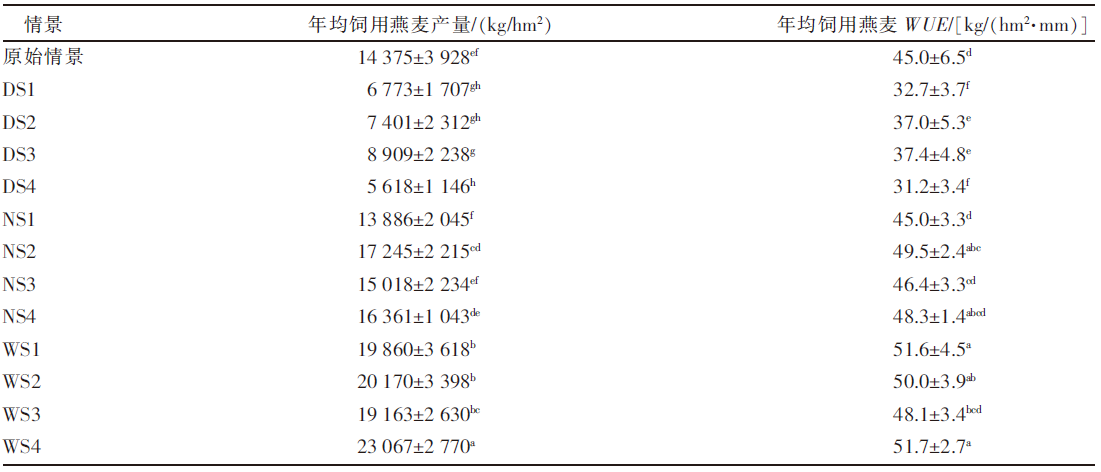| [1] |
高惠君, 刘金铜. 灌溉因素订正的北方农牧交错带界定[J]. 中国生态农业学报(中英文), 2021, 29(4):613-624.
|
| [2] |
李文龙, 石育中, 鲁大铭, 等. 北方农牧交错带干旱脆弱性时空格局演变[J]. 自然资源学报, 2018, 33(9):1599-1612.
doi: 10.31497/zrzyxb.20170896
|
| [3] |
李刚, 郑敏娜, 李荫藩. 饲用燕麦品种在晋北农牧交错区的生产性能和营养价值研究[J]. 中国农业科技导报, 2021, 23(12):42-53.
|
| [4] |
刘水华, 戴征煌, 于徐根, 等. 播种量和施肥对秋冬闲田种植燕麦草产量的影响[J]. 江西畜牧兽医杂志, 2018(3):37-39.
|
| [5] |
赵桂琴, 慕平, 魏黎明. 饲用燕麦研究进展[J]. 草业学报, 2007, 16(4):116-125.
|
| [6] |
白春利, 赵和平, 丁海君, 等. 饲用燕麦和草木樨混播栽培技术[J]. 畜牧与饲料科学, 2018, 39(9):62-64.
|
| [7] |
周磊, 王璐, 赵宝平, 等. 北方农牧交错区不同播期和刈割期对燕麦饲草产量和品质的影响[J]. 草地学报, 2021, 29(10):2355-2363.
doi: 10.11733/j.issn.1007-0435.2021.10.028
|
| [8] |
付东青, 王彦超, 宋磊, 等. 施氮量和种植密度对石河子复播早熟饲用燕麦生产性能的影响[J]. 草地学报, 2021, 29(10):2364-2371.
doi: 10.11733/j.issn.1007-0435.2021.10.029
|
| [9] |
张红娟, 李赟, 李雅丽, 等. 北方农牧交错带裸燕麦蒸散结构与灌溉制度优化研究[J]. 节水灌溉, 2022(3): 8-14.
|
| [10] |
娜日苏, 梁庆伟, 杨秀芳, 等. 沙地节水灌溉条件下苜蓿与饲用燕麦轮作的技术规程[J]. 当代畜禽养殖业, 2019(10):35-36.
|
| [11] |
赵宝平, 任鹏, 周磊, 等. 灌水模式对燕麦光合特性、干物质积累及产量的影响[J]. 内蒙古农业大学学报(自然科学版), 2021, 42(3):6-11.
|
| [12] |
KEATING B A, MEINKE H. Assessing exceptional drought with a cropping systems simulator: A case study for grain production in northeast Australia[J]. Agricultural Systems, 1998, 57(3):315-332.
doi: 10.1016/S0308-521X(98)00021-3
|
| [13] |
沈禹颖, 南志标, BELLOTTI B, 等. APSIM模型的发展与应用[J]. 应用生态学报, 2002, 13(8):1027-1032.
|
| [14] |
李广, 李玥, 黄高宝, 等. 基于APSIM模型旱地春小麦产量对温度和CO2浓度升高的响应[J]. 中国生态农业学报, 2012, 20(8):1088-1095.
|
| [15] |
KEATING B A, ROBERTSON M J, MUCHOW R C, et al. Modelling sugarcane production systems Ⅰ. Development and performance of the sugarcane module[J]. Field Crops Research, 1999, 61(3):253-271.
doi: 10.1016/S0378-4290(98)00167-1
|
| [16] |
ROBERTSON M J, CARBERRY P S, HUTH N I, et al. Simulation of growth and development of diverse legume species in APSIM[J]. Australian Journal of Agricultural Research, 2002, 53(4):429-446.
doi: 10.1071/AR01106
|
| [17] |
VERBURG K, KEATING B A, BRISTOW K L, et al. Evaluation of nitrogen fertiliser management strategies in Sugarcane using APSIM-SWIM[C]// Sugarcane:Research towards efficient and sustainable production.. Brisbane: CSIRO Division of Tropical Crops and Pastures, 1996:200-202.
|
| [18] |
PROBERT M E, DIMES J P, KEATING B A, et al. APSIM′s water and nitrogen modules and simulation of the dynamics of water and nitrogen in fallow systems[J]. Agricultural Systems, 1998, 56(1):1-28.
doi: 10.1016/S0308-521X(97)00028-0
|
| [19] |
RITCHIE J T. Model for predicting evaporation from a row crop with incomplete cover[J]. Water Resources Research, 1972, 8(5):1204-1213.
doi: 10.1029/WR008i005p01204
|
| [20] |
杨轩, 贾鹏飞, 侯青青, 等. 北方农牧交错带气候变化对粮草轮作生产的影响[J]. 山西农业大学学报(自然科学版), 2022, 42(1):77-89.
|
| [21] |
冯仰强, 聂志刚, 王钧, 等. 基于APSIM模型研究不同降水年型下降水变化对旱地小麦产量的影响[J]. 作物研究, 2021, 35(2):108-111,140.
|
| [22] |
DUGGAN B L, DOMITRUK D R, FOWLER D B. Yield component variation in winter wheat grown under drought stress[J]. Canadian Journal of Plant Science, 2000, 80(4):739-745.
doi: 10.4141/P00-006
|
| [23] |
罗兴雨, 李亚萍, 陈仕勇, 等. 高寒燕麦苗期抗旱性研究[J]. 西南农业学报, 2018, 31(9):1811-1816.
|
| [24] |
赵海超, 刘景辉, 任永峰, 等. 水分胁迫对内农大莜1号裸燕麦品种生长指标的影响[J]. 作物杂志, 2010(1):73-76.
|
| [25] |
贺伟. 不同灌溉方式对燕麦光合及土壤生物特性的影响[D]. 呼和浩特: 内蒙古农业大学, 2013.
|
| [26] |
姬文琴, 杨智, 汪辉, 等. 不同生育阶段燕麦对干旱胁迫的响应[J]. 中国草地学报, 2021, 43(1):58-67.
|
| [27] |
刘霞, 刘景辉, 李立军, 等. 耕作措施对燕麦田土壤水分、温度及出苗率的影响[J]. 麦类作物学报, 2014, 34(5):692-697.
|
| [28] |
王朝云, 揭雨成. 水分胁迫对红麻生理特性和产量的影响[J]. 作物学报, 1995, 21(6):746-751.
|
| [29] |
张继波, 薛晓萍, 李楠, 等. 水分胁迫对扬花期冬小麦光合特性和干物质生产及产量的影响[J]. 干旱气象, 2019, 37(3):447-453.
|
| [30] |
孙宏勇, 刘昌明, 张永强, 等. 不同时期干旱对冬小麦产量效应和耗水特性研究[J]. 灌溉排水学报, 2003, 22(2):13-16.
|
| [31] |
刘凯强. 水分胁迫对燕麦生长发育及产量构成的影响[D]. 西宁: 青海大学, 2020.
|
| [32] |
王冲, 林倩, 石晓宇, 等. 基于SIMETAW模型的不同地区燕麦需水量研究[J]. 中国农业科技导报, 2020, 22(3):131-139.
doi: 10.13304/j.nykjdb.2019.0017
|
| [33] |
亢秀丽, 靖华, 马爱平, 等. 黄淮海北片麦田微喷灌水量对土壤贮水耗水及水分利用效率的影响[J]. 水土保持学报, 2019, 33(1):221-226.
|




















